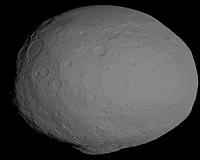 |
State College, Pa. (UPI) Apr 5, 2011 As a U.S. spacecraft nears a rendezvous with the asteroid Vesta, a centuries old debate has reignited -- is it an asteroid or should it be considered a planet? Vesta, orbiting the sun between Mars and Jupiter in the asteroid belt, is larger than most asteroids, which average 60 miles in diameter or less, accuweather.com's astronomy blog reported Wednesday. At 330 miles in diameter, Vesta has been classified a "minor" planet, a tag it now shares with Pluto since the solar system's ninth planet was "demoted." A "minor" planet is an object that circles the sun but is neither a proper planet nor a comet. In June, the NASA Dawn spacecraft will arrive at Vesta, and astronomers hope to get some data to help solve the argument. "I don't think Vesta should be called an asteroid. Not only is Vesta so much larger, but it's an evolved object, unlike most things we call asteroids," NASA investigator Tom McCord said. Some researchers favor the term "protoplanet," which they define as a dense, layered celestial body that began to form in the same way as the "normal" planets but never fully developed. They point to the fact that Vests has a core, mantle and a crust, just like Earth. "This gritty little protoplanet has survived bombardment in the asteroid belt for over 4.5 billion years, making its surface possibly the oldest planetary surface in the solar system," Christopher Russell of UCLA said. "Studying Vesta will enable us to write a much better history of the solar system's turbulent youth."
Share This Article With Planet Earth
Related Links Asteroid and Comet Mission News, Science and Technology
 When Is An Asteroid Not An Asteroid
When Is An Asteroid Not An AsteroidPasadena CA (JPL) Mar 30, 2011 On March 29, 1807, German astronomer Heinrich Wilhelm Olbers spotted Vesta as a pinprick of light in the sky. Two hundred and four years later, as NASA's Dawn spacecraft prepares to begin orbiting this intriguing world, scientists now know how special this world is, even if there has been some debate on how to classify it. Vesta is most commonly called an asteroid because it lies in the or ... read more |
|
| The content herein, unless otherwise known to be public domain, are Copyright 1995-2010 - SpaceDaily. AFP and UPI Wire Stories are copyright Agence France-Presse and United Press International. ESA Portal Reports are copyright European Space Agency. All NASA sourced material is public domain. Additional copyrights may apply in whole or part to other bona fide parties. Advertising does not imply endorsement,agreement or approval of any opinions, statements or information provided by SpaceDaily on any Web page published or hosted by SpaceDaily. Privacy Statement |